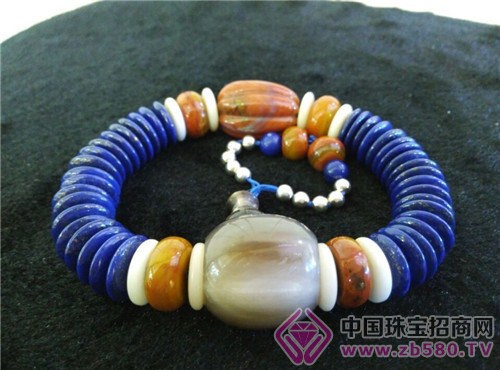Confused with lapis lazuli, there are the same group of mineral sodalite, blue smectite and mineral blue-copper ore of different ethnic groups but the same color. The counterfeit and substitutes posing as lapis lazuli have dyed chalcedony, dyed spinel, dyed jade, material. Imitation of green gold, dyed marble, these confusing companion minerals and counterfeits, substitutes are easily used by unscrupulous merchants, so it is necessary to recognize these "li ghosts" when collecting lapis lazuli, in case they are deceived.

Let's talk about the identification method:
1. Sodalite from the same family of lapis lazuli: belongs to the group of sodalite minerals, usually blue, a few white, green, red, purple or gray, Mohs hardness of 5.5~6.0, density It is 2.15~2.35, and the refractive index is 1.48~1.487. Crystals are rare and are produced in the form of massive, granular or tuberculous in nature. Generally, it has a glass luster, and on the cleavage surface, it is a grease luster.
Since it is a silicate mineral containing sodium, aluminum and chlorine, when silver nitrate and silver nitrate are added, a white silver chloride precipitate is produced. The appearance of sodalite is similar to that of lapis lazuli, so it is often used as a substitute for lapis lazuli, but sodalite rarely contains the pyrite-specific gold star of lapis lazuli.
Above is the square stone hand row
2. Opaque or translucent sky blue stone: aqueous phosphate mineral, an alkaline magnesium aluminum phosphate, in the form of glass-like blocks or granular crystals, generally mostly blue. The smectite is mostly opaque or translucent, and can be used as a gem material with a Mohs hardness of 5.5 to 6.0 and a density of 3.0 to 3.1.
3. The blue-copper ore with small hardness and brittleness: copper carbonate has a small hardness of 3.5~4.0, a refractive index of 1.73~1.83, brittleness, and no large dense block.
4. Dyed chalcedony (also known as "Swiss Green Gold") processed with chalcedony such as yellow wax stone: artificially colored with chalcedony and other fake materials, the hardness is large, mostly 6.5~7.0, such as yellow wax stone (aka " Huang Longyu"), the refractive index is 1.54~1.55.
5. Dyed spinel with high hardness ("dyed green gold"): artificially colored with cobalt salt, hardness is 8.0, and the refractive index is 1.71~1.72.
6. Strong gloss and dyed jade jade (also known as "ç‚色é’金"): light blue, can not see pyrite, strong grease gloss, hardness of 4.8 ~ 5.5, refractive index of 1.49 ~ 1.57.
7. Imitation of green gold with glass-like materials: made of glass, made of dyed dark blue sulfur or glass, no pyrite, glass luster, shell-like fracture, brittleness.
8. The dyed marble can be infused by the knife: the hardness is small, the knife is easy to inject, and the reaction with hydrochloric acid is obvious.
The above is the identification method of lapis lazuli that Xiaobian has organized through the network. I hope everyone can use it when choosing lapis lazuli.
Print Woven Dress,Twill Print Woven Dress,Straight-Leg Print Woven Dress,Woven Flower Dress
SHAOXING CHENYEE TEXTILE CO. LTD , https://www.fabriccy.com